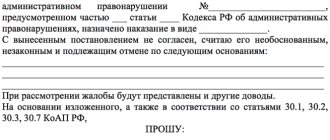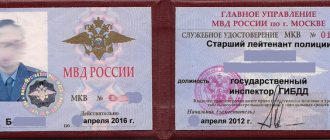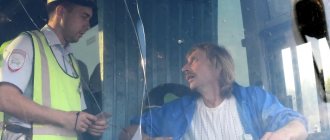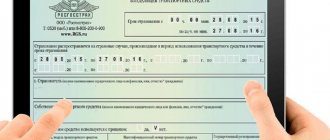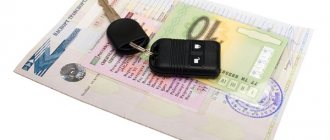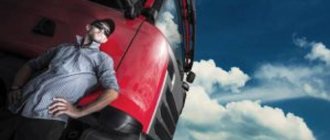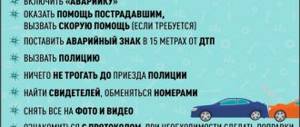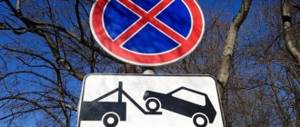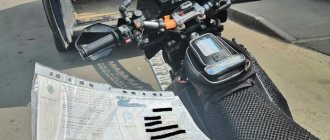Imagine the situation - you are driving a car to do your business. And suddenly traffic police officers appear in front of the car, slow down and start checking your license, insurance policy - everything is fine and you are about to drive on, and suddenly a traffic police officer asks you to open the trunk for inspection. What to do?
Naturally, you don’t have anything like that in it, and you, like a law-abiding citizen, lift the lid and present what is inside.
And it begins: where is your warning triangle, first aid kit and fire extinguisher? What lies here? Etc.
After these words, you begin to understand that you didn’t study the law in vain and are now frantically trying to remember at least something. We hope that the article below will help you avoid falling into similar situations.
Your actions: what should they be?
Let us immediately make a reservation that representatives of the inspection have the right to conduct either an inspection or search of the car. Let us explain the difference between these concepts. The inspection is visual, that is, when a traffic police officer walks around your car in a circle, checks the license plates and looks through the windows. That's all. This whole procedure is called a visual inspection.
But when you are asked to open the door of your “four-wheeled friend” to check the interior or luggage compartment, this is called an inspection. This means that the traffic police officer must present a documentary basis and two witnesses must be present at what is happening, plus a protocol must be drawn up.
If you start pointing this out to the inspector, he instructs you to find these witnesses yourself. Remember, it is his responsibility to look for witnesses. If the latter are not present, then the inspector must film the entire process.
Many traffic inspectors say to this: their actions are not an inspection, because they do not climb inside, but only look into the ajar door opened by you. It's still an inspection.
What to do if a police officer demands to see: a fire extinguisher, a warning triangle. Here, again, you need to go into the luggage compartment, so it turns out that you personally, voluntarily open it?
ATTENTION !!! Experts advise doing the following - announce to him that during the departure, all of the above items were in their places. But since he wants to make sure of this, then go ahead, please. But only under the protocol, in front of two witnesses or under a video camera. Or it will show you an article of law obliging you to do all this.
Otherwise, all his actions fall under the definition of arbitrariness. This is Art. 19.1 Code of Administrative Offences.
What to do if the inspector agrees to draw up a protocol? It’s okay, it’s his right, but again we repeat – he must find the witnesses and the video camera himself. In this case, passengers of your car or other traffic inspectors cannot act as witnesses. In addition, he must indicate in the protocol the reason for the search, and it must be compelling and supported by documents.
Sometimes, especially in the evening or at night, inspectors begin to drag their feet, because at this time on the road, especially outside a populated area, it is quite difficult to find witnesses.
In such a situation, we proceed as follows. We wait five minutes, after which we tell the officer who stopped you: if you are delayed further, you will call “02” and inform the officer on duty that the traffic police officer who stopped you is violating Art. 12.35 Code of Administrative Offences. This is an illegal restriction of the right to drive a car. The traffic policeman faces fines of up to 20 thousand.
IMPORTANT !!! Remember: the search should be carried out only in the direct presence of the car owner. The stopped policeman climbs into the passenger compartment or into the luggage compartment with his own hand, then the latter must be informed that such steps of his will be reclassified as a search, and this is a completely different article that requires judicial permission for this. If he wants to move something in the luggage compartment, he must ask you to do this.
During the inspection, some inspectors ask to show them what is in their bags and pockets. The law qualifies: “personal search” (see Article 27.7 of the Administrative Code). Two witnesses are required; remember, they must be the same gender as the driver. There is a girl driving, and the said search is carried out by an employee of her gender. With the preparation of a personal search protocol.
What to do if there are witnesses and a protocol
See also
Titan Trailer: modifications, where to buy, owner reviews
The inspector doesn't want to leave you behind. He must have compelling grounds and reasons to conduct an inspection. He himself looks for witnesses and also makes video recordings.
If the inspector does nothing but simply silently waits for your consent, remind him that he is violating your rights and limiting your freedom. This is a violation of the admin code.
Consider these points:
- the inspection is carried out in the presence of the car owner (driver);
- The inspector cannot see anything inside with his own hands;
- he must ask you to move something and show you.
Now let’s imagine that the inspector climbed into the trunk himself. He opens the bags and also looks into the packages. This is already a search. His actions are illegal. A search is allowed only if there is a court order.
Are the inspectors ignoring legal requirements?
Sometimes policemen do not pay attention to the driver’s requirements to comply with the law and begin to inspect the vehicle without recording it or inviting witnesses. He himself opens the doors, the luggage compartment, rummages in the purse, and demands that the pockets be turned out. Lawyers advise doing the following - call 102 and declare: an illegal search is being carried out in your car.
But remember: you should not interfere with the policeman in his actions. Especially standing in his way, offering physical resistance. Remember, the law can turn against you.
IMPORTANT !!! The best way out is to videotape everything that happens, since modern gadgets allow you to do this. Moreover, video footage serves as excellent evidence of police misconduct.
If possible, try to attract witnesses. They can also serve as passengers in your car. You can even attract passing pedestrians or try to stop passing cars.
After which you have ten days to appeal the employee’s actions. Your video recording and witness statements must be attached to the complaint.
Are the inspector's demands to get out of the car legal?
No inspector has the right to order the driver to get out of the car. But he may offer to leave in certain situations:
- When there is a need to eliminate technical malfunctions of the car;
- When it comes to violation of cargo transportation rules;
- If the driver shows signs of drug or alcohol intoxication, or a painful condition;
- When you need to check unit numbers;
- In a situation to provide assistance to victims.
If during the inspection data was discovered that indicates the direct commission of any administrative violation, the traffic police officer has the right to open a case about the corresponding administrative offense.
In accordance with the letters of the law, an appropriate protocol or entry in the document on administrative detention must be drawn up about the search. Please note: the protocol must indicate the place and date it was compiled, as well as the full name, title and position of the traffic police officer who compiled the protocol. In addition, this document must contain information about the witnesses (their full names, telephone numbers, addresses), the owner of the vehicle, information about things discovered during the inspection and the identification features of the car.
What does the law say? Are we studying legislation?
The complexity of the situation is as follows - our legislation does not contain a clear definition of these concepts: “inspection”, “inspection”, although they are described. Therefore, below we indicate extracts from several articles with the help of which you can save yourself from the arbitrariness of the traffic inspector.
Article 27.9. The Administrative Code states the following:
- In case of inspection of a vehicle, it is carried out without changing its design.
- The task is to discover the instruments for committing the offense.
- This type of activity can be carried out by persons specified in the Code of Administrative Offenses - 27.2, 27.3. if there are two witnesses at the time of inspection.
- The presence of the person driving the vehicle during the inspection or search by police officers is mandatory. There is an exception - circumstances do not tolerate delay, then it is allowed to carry out the specified activity without a person driving the vehicle;
- Taking photographs and video recording is allowed;
- Mandatory recording in the presence of witnesses. It should indicate the location of the inspection, information about the driver, and the car.
Within or outside the law?
One of the most controversial issues in the legislation that concerns road traffic is the vehicle inspection procedure. This situation is often due to the fact that many, having a rather superficial understanding of the legislation on inspection and inspection, immediately file for administrative arrest. But traffic police inspectors themselves do not always apply such procedures within the framework of current laws. Although these actions, in fact, violate the rights of citizens. Given this fact, it is extremely important to be aware of exactly when and under what circumstances a vehicle search is carried out.
How to behave?
Many drivers, having met with a traffic inspector, begin to fuss for no reason and ingratiate themselves. Traffic police officers immediately react to such behavior by the driver - after all, in their opinion, if a person is not guilty, then he does not worry. And they begin to insist on inspection.
ATTENTION !!! Therefore, behave confidently, do not shy away, do not ingratiate yourself, and do not become overly excited. On the contrary, show that you are persistent and principled. Let some “metal” into your voice.
Usually in such cases, inspectors retreat, because a conflict with a confident person can lead to unpredictable consequences. After all, the driver’s guilt has not been proven, and the inspector’s premonitions cannot be attached to the protocol.
Sometimes during an inspection, inspectors begin to attack the driver, saying that it is impossible to find the body number plates or they are dirty. And the driver must either find them and show them to the employees so that they can check them with what is written in the car documents. And if they are dirty, then clean them.
So, you don’t have to do all this. If the work surface is dirty, let him clean it himself. And you don't have to know where they are located. After all, it was registered by his colleagues from the MREO, so let him call them and find out.
In 2021, there are no articles in the laws obliging the person driving the vehicle to present a fire extinguisher or other items for inspection.
Does the driver have the right not to open the trunk?
When a traffic cop politely asks to see the trunk, this cannot be interpreted as a violation. However, the driver is not required to comply with the requirement. Thus, from a legal point of view, the refusal of the car owner to open the trunk will not have any consequences, but the patrolman in response may demand to show what the car owner is transporting.
From this moment, the patrolman’s actions become an inspection; accordingly, witnesses are invited, a protocol is drawn up, and the driver is obliged to fulfill all the requirements of the traffic police representative.
What should drivers not do?
The World Wide Web and television broadcasts show footage of police officers starting to break car windows and pull the person behind the wheel out of the window. And everyone around is talking about the unlawful actions of the police. They do not pay attention to the actions that preceded this event.
The thing is that people driving on the roads want to increase their rating on various social networks. It is precisely those citizens who begin to actively defend their rights. This is expressed by wild screams in the face of a police officer. And he hadn’t even had time to introduce himself yet. Do not be like such individuals, obey the law and be prudent. And in difficult situations requiring special knowledge and experience, our lawyers are always ready to provide you with qualified legal assistance.
How to act correctly
Let's say you come across a persistent inspector who knows no boundaries and is in no hurry to comply with the law.
He made the following mistakes:
- began to conduct an inspection;
- climbed into the trunk;
- started rummaging around in the cabin and in the glove compartment;
- gets into bags and packages;
- did not draw up a protocol;
- did not stop the witnesses.
The framework of laws is far from his actions. He does everything wrong. Relying on the naivety of the driver, as well as on their own impunity.
Yes, he clearly violates the law and your rights. But you need to act wisely:
- Call the police immediately;
- report that an illegal search is being conducted;
- do not interfere with the employee, even if he is wrong;
- film all his actions;
- attract witnesses;
- within 10 days, write a complaint to the prosecutor’s office and to the court;
- attach videos, photos, and witness statements.
This way there will be no complaints against you. And the probability of winning in such a case is high.
When the police have the right to inspect different compartments of a vehicle (the difference between inspection and search)
Vehicle inspection – visual check for compliance with documents (technical passport, etc.).
In addition, if a mobile post is placed along the route of the vehicle as part of the training of operational guidelines for theft, and the stopped car corresponds to the description in the report, then the traffic police inspector has the right to demand that the driver open the hood and check the license plates. This is also a vehicle inspection.
The police officer's procedure in this case:
- after studying the documents on the car, he must inform the motorist of the reasons for conducting an inspection of the engine compartment;
- demand that the hood be opened (if for some reason it does not open, the car may be arrested and transported to the impound area);
- fill out an inspection report and indicate in it the numbers of the units actually marked on the car components;
- hand a copy of the document to the driver.
How to transport oversized cargo - what do traffic regulations say in 2021?
As part of the inspection, the inspector is prohibited from opening the trunk and doors to the passenger compartment. If the guard decides to search them, then he must have good reasons for this.
Let us remind you that if a driver voluntarily allows himself and his belongings to be searched, then it will be difficult to substantiate claims against the policeman.
Inspection – inspection of the trunk and passenger compartment. It does not matter whether the police officer plans to inspect the cabin.
If he wanted to check the cargo compartment, then this is already an inspection, for which there can be two reasons:
- the driver has committed an administrative offense and, as part of the investigation, the traffic police is conducting an inspection;
- the inspector has reasons to believe that the vehicle is carrying weapons, drugs or other items prohibited for free circulation in the Russian Federation.
There are no other reasons for inspection.
Personal search and search of motorist's pockets
During a roadside check, a situation may arise when traffic police officers intend to conduct a personal search of the driver. As part of this procedure, a citizen may be asked to show the contents of his pockets and personal belongings.
Protocol on an administrative offense - how can a driver protect his rights?
In this case, you need to be especially careful, since it is obvious that the policeman has some suspicions, and he will be persistent in his demands. Moreover, it is possible that the inspector will allow the use of physical force if, in his opinion, you behave inappropriately in the situation.
Procedure for conducting a personal search:
- witnesses are involved (mandatory, even if there is video recording) and their rights and obligations are explained to them;
- after this, the inspector invites the motorist to independently show the contents of his pockets, hand luggage and luggage (everything is entered into the protocol);
- If the person being searched refuses, the traffic police officer has the right to use physical force.
Everything that happens during the inspection is recorded and accompanied by explanations from the driver.
In what cases is LD allowed:
- to prevent a crime (if the police officer believes that you are under the influence of alcohol or drugs);
- for the seizure of items used for illegal actions (when drawing up an administrative protocol).
Therefore, if you followed traffic rules and behaved appropriately to the situation during control, then no one should commit traffic violations.
Does a traffic police inspector have the right to open the trunk, hood and doors of a car?
The vehicle consists of three main compartments: engine, passenger and cargo. Only the owner and legal user have free access to the vehicle compartments. Other persons: passengers, representatives of supervisory authorities, traffic police inspectors, etc. are allowed to inspect and use the listed compartments only with the consent of the owner/user or in the presence of grounds provided by law.
Responsibility for the vehicle and everything in it lies with the motorist who is driving at the time of control.
If you are stopped by a traffic police inspector, then you yourself must make one of the possible decisions:
- get out of the car / stay in the driver's seat;
- allow passengers to open doors / prohibit them from doing so;
- voluntarily allow a police officer to check the trunk and license plates in the engine compartment / refuse to voluntarily show the contents of the car to a security officer.
GPS beacon for a car - will it help you find a stolen car?
But if the driver is against such examinations and demands the policeman to justify the order, then the controller is obliged:
- notify the driver of what procedural action needs to be taken;
- list the legal grounds for this;
- provide the name and procedure for drawing up the document that will record the procedure;
- invite witnesses and inform them of their rights and obligations (if required by law);
- ask to open the hood, doors, trunk.
Interfering with the legitimate orders of a traffic police officer is prohibited. If at least one item on the list is not met, then the actions of the traffic cops are illegal and can be appealed in court and/or to the prosecutor's office, but you are still required to open the trunk to a traffic police inspector.
Important points
In such cases, the traffic police inspector has the right to demand that you follow him and may even, if necessary, apply preliminary administrative detention to the driver. Please note: a report on such an arrest can be drawn up immediately after the arrest and transfer to the police station. In this case, the participation of witnesses is not mandatory. All materials received during the procedure, as well as recording of material evidence, are attached to the corresponding protocol.
This protocol must be signed by the inspector who compiled it. Also here must be the signatures of the owner of the car that was inspected, and the person against whom proceedings for an administrative offense were initiated. If the owner of the vehicle or someone else refuses to sign such a document, a corresponding entry about this must be made in the document. A copy of the protocol is given to the owner of the car that was subject to inspection.
Policeman demands to show first aid kit, fire extinguisher and warning triangle (ZAO)
Sometimes the inspector asks to open the trunk, citing the fact that the driver must present the company for inspection.
In this situation the policeman is wrong. When stopping to check documents, the motorist is not required to present the above equipment to the traffic cop for inspection.
The police can impose fines for the absence of a joint stock company in a car only when these items were not used by the driver if necessary, and this created an emergency situation on the road or caused harm to other road users.
So, for example, if there was an accident or a vehicle breakdown, and the motorist did not display an emergency stop sign, then the traffic police inspector can record the offense and draw up an appropriate protocol.
